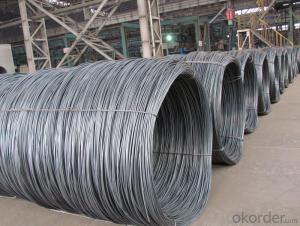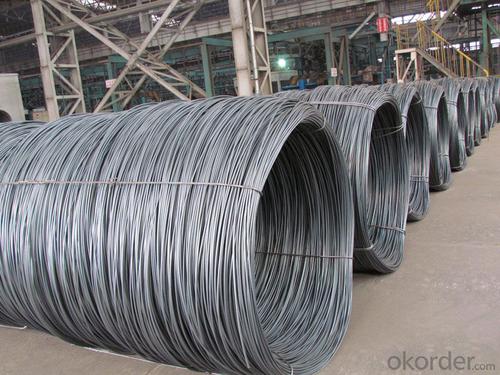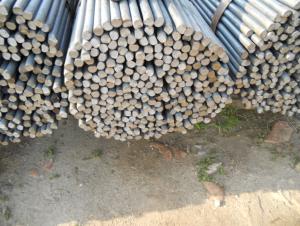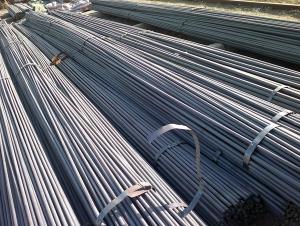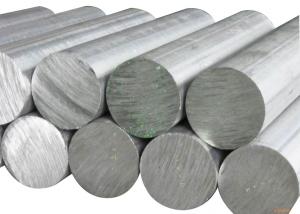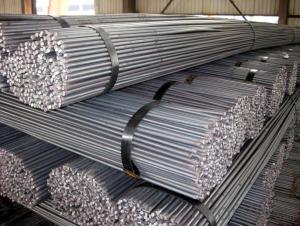Steel Round Bar In Coil
- Loading Port:
- China Main Port
- Payment Terms:
- TT OR LC
- Min Order Qty:
- -
- Supply Capability:
- -
OKorder Service Pledge
OKorder Financial Service
You Might Also Like
Specifications of Hot Rolled Wire Rod:
Steel Grade: Q195/235, SAE1006-1018B Standard: ASTM, GB
Diameter: 5.5mm, 6.5mm, 7mm,8mm,9mm,10mm,12mm,14mm
Type: in coil, coil weight around 2MT Alloy or Not: Alloy
Technique: Hot Rolled Place of Origin: China Mainland
Surface: round, no twisted, light and smooth Brand Name: HSKY
Chemical Composition: (Please kindly find our chemistry of our material based on Q195、Q235A and Q235B as below for your information)
| Trademark | Rank | Chemical composition (quality score) % | ||||
| C | Si | Mn | S | P | ||
| | ||||||
| ≤ | ≤ | ≤ | ||||
| Q195 | 0.06-0.12 | 0.30 | 0.25 | 0.050 | 0.045 | |
| Q235 | A | 0.14-0.22 | 0.30 | 0.30-0.65 | 0.050 | 0.045 |
| Q235 | B | 0.12-0.20 | 0.30 | 0.30-0.70 | 0.045 | 0.045 |
Usage and Applications of Hot Rolled Wire Rod:
After hot-rolled the products shaped into coil and delivery as finished product, including round, square, rectangular, hexagonal and so on. Since most of the products are round, it is generally called wire rod. Carbon steel wire rod is widely used in construction and manufacturing. Carbon steel wire rod is mainly used for reinforcement of reinforced concrete and welded structure or reprocessed (roberts , nail, etc.) materials, especially used to produce wire drawing, welding electrode, nails, spring, electronic, precise machinery parts and so on.
Packaging & Delivery of Hot Rolled Wire Rod:
Packaging Detail: products are packed in coil, each coil weight around 2 MT, and then shipped by container or bulk vessel
Delivery Detail: within 45 days after received deposit or LC.
Label: to be specified by customer, generally, each bundle has 1-2 labels
Trade terms: FOB, CFR, CIF
- Q: What are the standard tensile strength requirements for steel wire rod?
- The tensile strength requirements for steel wire rod vary based on factors such as the specific application, industry standards, and regulatory requirements. Generally, steel wire rod has a minimum tensile strength of 500 MPa or 72,500 psi to ensure it can withstand expected mechanical stress and loading conditions. It is worth mentioning that the required tensile strength may differ depending on the steel type, manufacturing process, and desired product properties. Hence, referring to industry standards or specifications is essential for determining the precise tensile strength requirements for a particular application.
- Q: What are the strength requirements for steel wire rod used in suspension bridge wire strands?
- The strength requirements for steel wire rod used in suspension bridge wire strands can vary depending on several factors. Generally, the wire rod must possess high tensile strength to withstand the immense loads and stresses that suspension bridges are subjected to. The wire rod must have a minimum yield strength and ultimate tensile strength that meets or exceeds the design requirements for the suspension bridge. The yield strength refers to the amount of stress that the wire rod can withstand before it begins to deform permanently, while the ultimate tensile strength indicates the maximum stress the wire rod can endure before it breaks. In addition to high strength, the wire rod must also exhibit good ductility and toughness. Ductility refers to the ability of the material to deform without fracturing, while toughness is its ability to absorb energy without fracturing. These properties are crucial for structural integrity as they allow the wire strand to flex and absorb dynamic loads, such as wind or vehicle vibrations, without failure. Furthermore, the wire rod should have excellent corrosion resistance to ensure the longevity and durability of the suspension bridge. Corrosion can weaken the wire strands over time, compromising the structural integrity of the bridge. Therefore, the wire rod must possess a protective coating or be made from corrosion-resistant alloys to withstand exposure to environmental factors such as moisture, saltwater, and pollutants. Finally, the dimensional requirements of the wire rod, including its diameter and surface finish, must also meet the specifications of the suspension bridge design. These dimensions are crucial for maintaining the desired strength and performance characteristics of the wire strands. In summary, the strength requirements for steel wire rod used in suspension bridge wire strands include high tensile strength, good ductility, toughness, corrosion resistance, and adherence to dimensional specifications. Meeting these requirements ensures the wire strands can withstand the significant loads and environmental conditions experienced by suspension bridges, ensuring their structural integrity and safety.
- Q: Use of high carbon steel wire rods
- Main applications: mainly used in the processing of carbon spring steel wire, oil quenching and tempering carbon spring steel wire, prestressed steel wire, high-strength quality carbon structural steel wire, galvanized steel wire, galvanized stranded wire, steel wire rope and so on.
- Q: How is steel wire rod used in the manufacturing of conveyor belts?
- Steel wire rod is used in the manufacturing of conveyor belts as it provides strength and durability. The wire rod is used to create the core of the conveyor belt, providing stability and support. It is also used to reinforce the belt, ensuring it can withstand heavy loads and high tension. Additionally, the steel wire rod is coated with various materials to enhance its corrosion resistance and improve the belt's overall performance.
- Q: How is steel wire rod used in the manufacturing of wire for electrical circuitry?
- Steel wire rod is used in the manufacturing of wire for electrical circuitry as it serves as the primary material for wire production. The wire rod is first processed through various steps like cleaning, annealing, and drawing to attain the required diameter and conductivity. These wire rods are then further processed and coated with insulating materials to create insulated wires, which are essential for electrical circuitry applications.
- Q: What are the different types of steel wire rod coatings used for increased hardness?
- To enhance the hardness of steel wire rods, various coatings are utilized. These coatings are applied to the surface of the wire rod to augment its strength, durability, and resistance to wear. Some commonly employed coatings are as follows: 1. Galvanized Coating: Widely used, this coating involves the application of a zinc layer to the wire rod through hot-dip or electroplating techniques. The zinc coating offers excellent corrosion resistance and increases the wire rod's hardness. 2. Zinc-Aluminum Coating: By combining zinc and aluminum, this coating provides improved hardness and corrosion resistance. It is applied using a hot-dip process, resulting in a more durable and long-lasting coating compared to regular galvanized coatings. 3. Copper Coating: Copper coatings enhance the wire rod's hardness and electrical conductivity. This type of coating finds common use in electrical wiring and grounding applications where electrical conductivity is essential. 4. Nickel Coating: Renowned for their exceptional hardness and corrosion resistance, nickel coatings are often applied to steel wire rods used in high-stress applications requiring wear resistance, such as springs, cables, and fasteners. 5. Chrome Coating: To increase the hardness and wear resistance of steel wire rods, chrome coatings are employed. This process entails electroplating the rod with a layer of chromium, which exhibits excellent resistance to abrasion and corrosion. 6. Ceramic Coating: A relatively new addition to steel wire rod coatings, ceramic coatings consist of ceramic particles applied to the rod's surface using specialized techniques like plasma spraying. These coatings offer outstanding hardness, wear resistance, and thermal stability, making them ideal for demanding applications like cutting tools and industrial machinery. It should be noted that selecting the appropriate coating for a specific application relies on factors such as intended use, environmental conditions, and desired performance characteristics. Seeking guidance from a materials engineer or coating specialist would be advantageous in determining the most suitable coating for increased hardness in steel wire rods.
- Q: What are the different surface coating materials used for steel wire rod?
- Steel wire rods can be enhanced and protected from corrosion by using various surface coating materials. Galvanized wire rods, which are coated with zinc, are widely used due to their excellent corrosion resistance. Epoxy coatings are suitable for wire rods that require protection against chemicals, moisture, and abrasion. Phosphating, on the other hand, involves converting the metal surface into a layer of phosphate crystals to improve adhesion and overall appearance. Polymer coatings, such as PVC or PE, are chosen for their specific properties like electrical insulation or UV resistance. Organic coatings, including paints and lacquers, not only provide aesthetic appeal but also protect against corrosion. The selection of the appropriate coating material for steel wire rods depends on factors such as the intended application, environmental conditions, and desired properties. Manufacturers carefully consider these factors to ensure the wire rod meets the specific requirements of the end product.
- Q: How is steel wire rod stored to prevent corrosion?
- To minimize the risk of corrosion, steel wire rods are typically stored in specific ways. One method involves placing the rods in a well-ventilated area with controlled humidity levels, preventing moisture accumulation and accelerating the corrosion process. Another preventive measure is to store the rods in a dry environment, elevated off the ground. This can be achieved by using pallets or racks to keep the rods from direct contact with the floor, avoiding any potential moisture or water accumulation on the ground. Furthermore, steel wire rods can be stored indoors in a warehouse with climate control. By maintaining a stable temperature and humidity level, the chances of corrosion are significantly reduced. These controlled environments effectively minimize moisture exposure and prevent rust formation on the wire rods. Additionally, a common preventive measure involves applying a protective coating to the steel wire rods. Coatings such as zinc or epoxy act as barriers between the rods and the surrounding environment, effectively preventing moisture from reaching the surface and causing corrosion. Overall, proper storage of steel wire rods entails minimizing moisture exposure, maintaining controlled humidity levels, elevating the rods off the ground, and using protective coatings. These measures greatly reduce the risk of corrosion, ensuring that the wire rods remain in optimal condition until they are ready for use.
- Q: What are the different packaging materials used for steel wire rod?
- The different packaging materials used for steel wire rod include wooden pallets, steel frames, steel strapping, and plastic wrapping.
- Q: What are the different surface finishes available for processed steel wire rod?
- Processed steel wire rods can be finished in several ways, each with its own distinct characteristics and uses. Some commonly used surface finishes include: 1. Bright Finish: This is the most commonly employed and basic surface finish for steel wire rods. It is achieved through acid pickling and subsequent cold rolling, resulting in a smooth and shiny appearance. Bright finish wire rods are suitable for general applications where aesthetics and corrosion resistance are not major concerns. 2. Coated Finish: Steel wire rods can be coated with different materials to enhance their performance and functionality. Common coating materials include zinc (galvanized finish), copper, nickel, or a combination of these. Coated finishes offer improved corrosion resistance, increased durability, and enhanced electrical conductivity, making them suitable for specific applications such as fencing, electrical wiring, or automotive components. 3. Cold Drawn Finish: This surface finish is achieved by pulling the wire rod through a series of dies, reducing its diameter and increasing its tensile strength. Cold drawn wire rods have a polished and smooth appearance, making them ideal for applications requiring high strength and precision, such as automotive parts, springs, or fasteners. 4. Phosphated Finish: This surface finish involves coating the steel wire rod with a layer of phosphate to improve its corrosion resistance and enhance its lubrication capabilities. Phosphated wire rods are commonly used in applications where lubrication is necessary, such as the production of screws, bolts, or chains. 5. Galvannealed Finish: This surface finish combines the benefits of galvanizing and annealing processes. The steel wire rod is first coated with a layer of zinc and then heated to allow the zinc to alloy with the metal surface. Galvannealed wire rods exhibit excellent corrosion resistance and can be easily painted or welded. They are commonly utilized in the manufacturing of automotive parts, appliances, or construction materials. To sum up, the range of surface finishes available for processed steel wire rods offers a wide array of properties and applications. Whether it is for improved corrosion resistance, enhanced strength, or specialized functions, each finish provides unique advantages to cater to various industries and specific requirements.
Send your message to us
Steel Round Bar In Coil
- Loading Port:
- China Main Port
- Payment Terms:
- TT OR LC
- Min Order Qty:
- -
- Supply Capability:
- -
OKorder Service Pledge
OKorder Financial Service
Similar products
Hot products
Hot Searches
Related keywords
